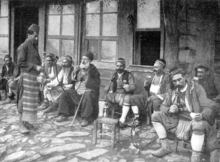Turkish tea rooms in Germany
As a result of immigration from Turkey to the Federal Republic of Germany, Turkish tea rooms in Germany increasingly emerged from the 1980s onwards, based on the model of the kahvehane , the village and neighborhood cafés found in Turkey , in urban areas of western Germany , but they show characteristic differences from the Turkish model on.
Named the tearooms after there primarily consumed drink tea . For part of the Turkish immigrant society, the localities are or were considered to be an important social meeting point.
Origin and developments
The language barrier and the serving of alcoholic beverages were the reason for a number of Turkish immigrants of the first generation to avoid German pubs . The first alternative meeting points were created in the 1960s and 1970s. Otherwise, in addition to its early significance for the first generation, the tea room is to be understood as a piece of home in its function and social significance as a counterpart to the German provincial pub, in particular the later heavy use by members of the second generation in the 1990s. "Discussions, playing cards or football", but also smoking, are named as usual activities in tea rooms. The bars are almost exclusively used by men, although there is no explicit ban on women. With the rise of unemployment , according to social scientist Rauf Ceylan, the function of the tea room changed even more towards a meeting point. While orders are usually a prerequisite for accommodating a guest in German cafés, the unemployed tea room guest is usually also welcome when he is not consuming. For him, according to Ceylan, staying in the tea room is a way of relieving family stress and conflicts and escaping social pressure.
Both due to the situation in the diaspora (the first club rooms of Turkish workers' associations around 1963 were mostly set up in the form of tea rooms) and more recent problems such as unemployment, the tea room in Germany has become more of an "identity-creating place" than the coffee house in Turkey, where some of the Turks in Germany experience special solidarity and mutual help.
The tea rooms in Germany are mostly financed solely from the sale of drinks, which offers the café operator a large profit margin on tea despite a glass price of usually just one euro.
Facility
The facilities in tea rooms in Germany are often similar. Characteristic are tiled floors, a relatively short counter and only a few large tables in the center of the room. A mostly large-format television set under the ceiling offers reception facilities for football games and Turkish programs. A particularly blatant difference to the German pub is the lighting: this is often extremely bright and is usually provided by neon tubes.
literature
- Rauf Ceylan: Ethnic Colonies. Origin, function and change using the example of Turkish mosques and cafes . VS Verlag für Sozialwissenschaften, Wiesbaden 2006, ISBN 978-3531152585
Web links
Individual evidence
- ↑ a b Engelmeyer / Zander: Expeditions into the tea area ; DUMMY No. 15: Turks, June 18, 2007, p. 47 f
- ↑ a b c Turkish tea rooms in Germany - communicative meeting point for men on ZDF . Retrieved November 19, 2009
- ↑ cf. Rauf Ceylan: Ethnic Colonies: Origin, Function and Change Using the Example of Turkish Mosques and Cafés , VS Verlag für Sozialwissenschaften, Wiesbaden 2006, ISBN 978-3531152585
- ↑ Dietrich Thränhardt, Uwe Hunger: Immigrant networks and their integration quality in Germany and Israel , Lambertus, 2000, ISBN 978-3784112824 , page 98


